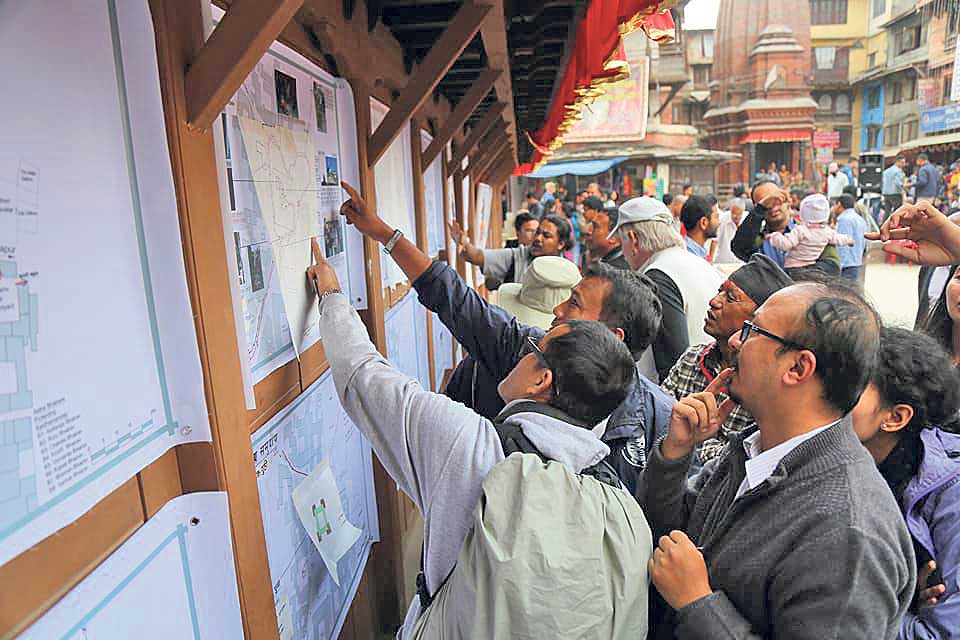60 artworks by 50 artists exhibited in Thamel
19 hours ago
We are a team of professional management and journalists — one of the best in the Nepali media. Our duty toward our readers is to provide them with impartial news, bold views, in-depth analysis and thought-provoking commentary. We shall do this without fear or favor, and we shall be guided by nothing but our conscience.
Know More
19 hours ago

5 days ago

14 days ago

KATHMANDU, Nov 1: An unprecedented example of community’s involvement in the rebuilding process of fallen heritages unfolded over the weekend with the citizen-led Rebuild Kasthamandap movement publicly showcasing its progress in the preparatory tasks for the reconstruction of the iconic seventh-century shelter.
Locally known as Maru Satah (meaning the shelter located in Maru in Nepal Bhasa), Kasthamandap has stood tall as a symbol of communal harmony and openness until it collapsed to the ground in the April 2015 earthquake.
According to the press statement released Rebuild Kasthamandap’s three-day workshop, held with the theme “Let's Engage and Interact to Rebuild Kasthamandap” came to a meaningful conclusion on Saturday.
In the open space of Maru adjacent to the ruins of Kasthamandap, an exhibit was set up comprising a miniature paper model of Kasthamandap, the architectural drawings prepared by Rebuild Kasthamandap’s architects and graphical representations of social, cultural and religious activities that have been practiced by different community groups in and around Kasthamandap for centuries.
Visitors and passersby were encouraged to point out how they used the physical space of Kasthamandap on a large diagram that showed Kasthamandap and its periphery.
Interested people were also asked to speak briefly on any aspect of the rebuilding process. In addition, close to one hundred individuals submitted their feedback in written form.
While most of the opinions and suggestions collected at the event dealt with the graphical presentations displayed at the event, some of them covered broader areas such as governance issues related to community-led reconstruction, raising funds, quality control and revival of traditional practices and socio-cultural activities linked with Kasthamandap once the physical reconstruction is completed.
People who attended the event shared that they still hold a deep interest in the reconstruction of Kasthamandap, and to do it the right way – more resilient to future disasters, while maintaining its originality.
The attendees were engrossed in learning proper ways of rebuilding the landmark, be it professionals who came there with the specific intent of giving technical advice, or casual passersby whose attention were drawn to the attractive display and stopped by to express their two bits.
Many a visitor also got carried away with emotion, reminiscing on the good times they had spent at Kasthamandap as a pivotal point of their daily lives.
Prior to the event, the non-profit group registered as the Campaign to Rebuild Kasthamandap had organized two separate focused-group workshops, the outcome of which formed the basis of the public display and dialogue held Saturday.
The first day of the workshop mapped out the linkages of various community groups involved in Kasthamandap’s intangible heritage to learn more about the guthis, rituals and jatras performed in and around Kasthamandap.
The workshop also became a platform for the community members to learn about each other’s involvement with Kasthamandap for cultural, social and religious practices that have lasted over a millennium, and gave a clear picture of the importance of documenting the heritage – both tangible and intangible – to preserve it for the benefit of our future generations.
On the second day of the workshop, Rebuild Kasthmamandap’s team of architects and engineers had presented the architectural drawings and the structural analysis they had prepared to a panel of reputed conservationists, including Prof Dr Sudarshan Raj Tiwari, Rabindra Puri, Dr Santosh Shrestha, Rabi Jonchhe and Ramprasad Suwal. The session yielded high-value, practical and contemporary critique from the experts, which will be incorporated in the next revision of the drawings.
Similarly, archeologist Prakash Darnal and ancient inscription specialist Kashinath Tamot had provided their insights on the intangible aspects of Kasthamandap that give life to the tangible properties of the structure.
Leave A Comment